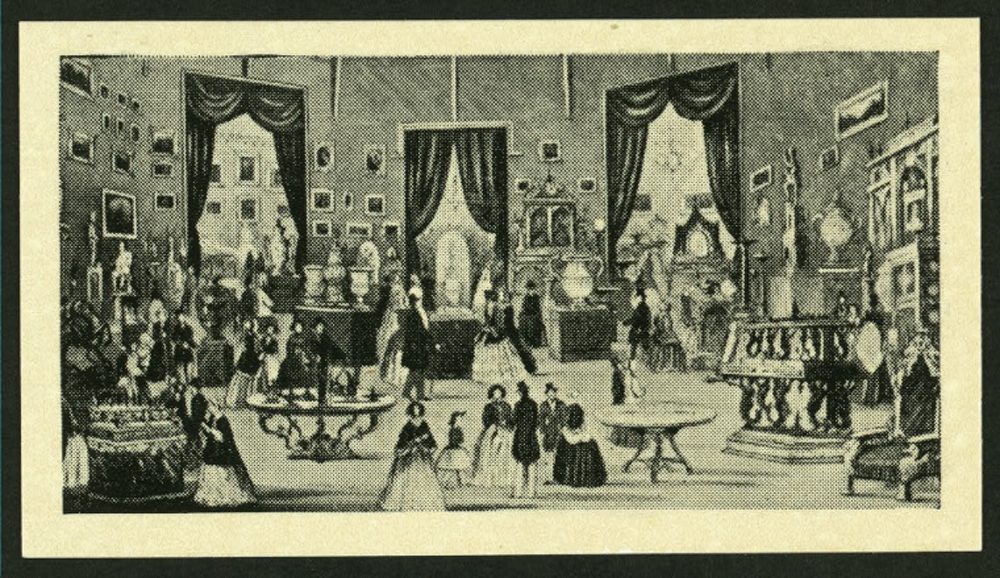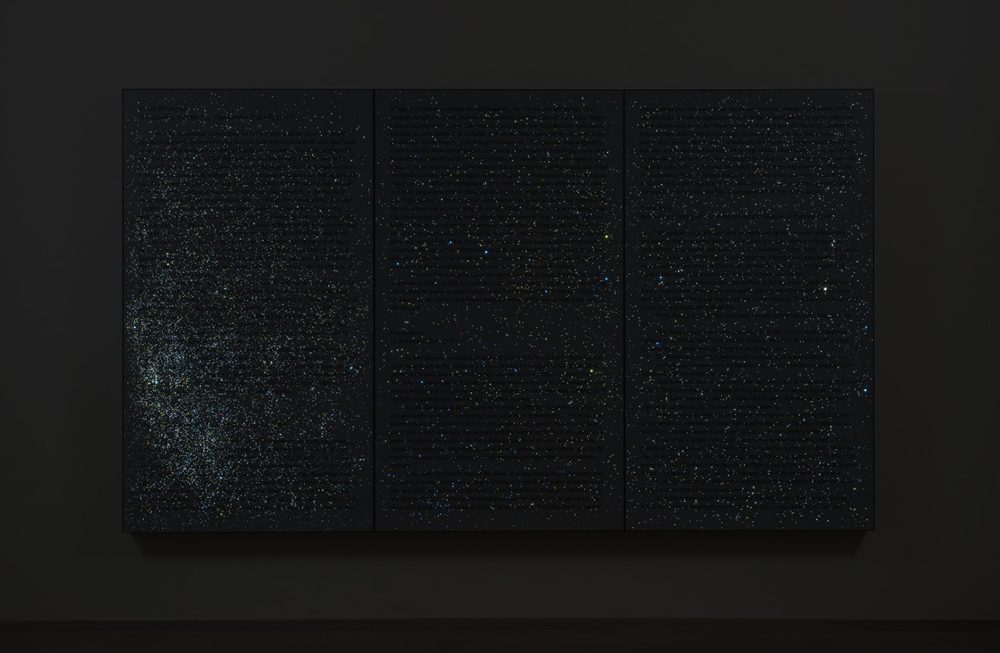Biennials on the International Stage
Emily Wilkerson, Project Manager at Prospect New Orleans, looks at the history of international exhibitions and thinks about the potential of biennials to cross borders.

A cigarette card depicting the Great Exhibition at the Crystal Palace, London. Image via the New York Public Library.
During 2014’s “Prospect.3: Notes for Now”—the third iteration of the city-wide contemporary art triennial in New Orleans—the Contemporary Arts Center was filled with a selection of abstract paintings, figurative works, video installations, and fish tanks full of coral—all pieces created by artists from around the world. Tucked away on the second floor in its own viewing room was Charles Gaines’ Skybox I, 2011. The work is comprised of three large light boxes that alternately show a glimmering night sky and grey book pages with excerpts from texts by Gerrard Winstanley, Léopold Sédar Senghor, Frantz Fanon, and Ho Chi Minh. The gracefully immersive work begged questions of how these texts addressing issues of freedom, democracy, and oppression, from different societies, cultures, and times, remain relevant in the context of Prospect specifically, and, even more so, in the city of New Orleans.
The model of contemporary art biennials, upon which Prospect is based, emerged with the Venice Biennale, which was founded in 1895 to be the first international art exhibition. By 1907—a moment when Europe’s powers were vying for world dominance—the national pavilions opened as part of the exhibition, ostensibly to showcase the best and brightest artists representing each nation’s place and people. The Venice Biennale, now approaching its 57th iteration next year, is the longest running biennial exhibition, but it is predated by general expositions, such as those that started in Europe about a half-century earlier in the Crystal Palace of London and the subsequent World’s Fairs. These expositions were intended to highlight the accomplishments of the industrialization era, while serving as an educational tool for international art and culture and a platform for trade and tourism. It is not difficult to find parallels between contemporary international biennials and the World’s Fairs of the past; further, as critic and curator Ranjit Hoskote has pointed out, the public nature of biennials can even be linked to common attractions like zoos and pageants. And so it continues: looking, parading, traveling, and trading.
While the traditional model is a biennial—occurring every two years—other exhibitions occur over varying time frames such as every three (like the schedule Prospect New Orleans has since adopted), five (documenta), or even ten years (Skulptur Projekte Münster). Some have been established in the aftermath of disasters or large societal and political shifts: Prospect New Orleans was founded, in part, as a tool to regenerate the cultural economy of the city after Hurricane Katrina, and the Gwangju Biennial was founded in response to the repression of civilians during the Gwangju Democratization Movement in South Korea. Among the plethora of biennials around the world today, most, such as documenta in Kassel, Germany, or Dak’Art in Dakar, Senegal, offer a pulse of international contemporary art, connecting the host cities to artistic practices and conversations from around the globe.

Charles Gaines, Skybox I, 2011. Acrylic, digital print, polyester film, LED lights, changing light system, fixtures, and tracks. Courtesy the artist and Paula Cooper Gallery, New York.
Regardless of the timing, the impetus of these exhibitions is the contemporary nature of the artwork. Biennials often offer participating artists the freedom to work outside of a typical practice and to make site-specific work, responding intuitively to their surroundings. Furthermore, they provide viewers opportunities to see artists’ works that may not normally be exhibited in a particular place, as well as a platform to engage in discussions and interactions with others beyond gallery walls. This exhibition format gives an opportunity to expose and interpret perceptions of one’s or another’s nation or nationality, and, at their best, international biennials are platforms to question ideas of who we are and also how we are interrelated. What does it mean—for artists and viewers alike—to tell one’s story or share an experience in a different setting, beyond the museum, gallery, or the studio? How do those stories and experiences resonate in one place versus another? In Hoskote’s words, writing about “biennials of resistance,” the nature of the biennial is “neither exclusively nor even primarily a space of spectacular doing, but rather a discursive environment, a theater that allows for the straying of arguments, speculations, and investigations concerning the nature of our shared, diversely veined, and demanding contemporary condition.”
In 2014, for Iceland’s national pavilion at the 56th Venice Biennale, Christoph Büchel converted, with the help of locals, an unused Catholic church into a mosque in an attempt to highlight the immense influence of Islam’s trade and culture on Venice’s art and architecture. Before the exhibition opened, police shut down the project, citing possible threats from Islamic and anti-Islamic extremists and additionally arguing that the artist was violating building codes. As described in The New York Times report on the project, Mohamed Amin Al Ahdab, president of the Islamic Community of Venice, said, “Sometimes you need to show yourself, to show that you are peaceful and that you want people to see your culture.”
As events like those in Venice unfold, it’s helpful to return to Gaines’ work in Prospect.3, and the texts and visuals he set before us. Although Skybox I was made three years prior to its exhibition in New Orleans, the questions and ideas it presents remain relevant here today, and across the globe. This is a city whose foundation was built by and continues to grow from a multitude of peoples, through shared and distinct histories, despite imagined boundaries and differences. And when we consider the ways in which where we come from impacts our lives—the availability of fair housing, access to food and education, income equality—we are drawn back into one of Gaines’ key questions for the viewer: What does freedom really mean? Within the galleries and installations, we realize this question, along with the many others artists pose to viewers throughout the exhibition, is not one inherent to a particular place. As Gaines suggests, we all share the night sky.



